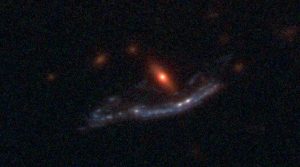
One of the recurring themes around here is that “astronomers desperate for data use gravity as a lens to magnify the early universe.” We’ve talked a bunch about how folks have looked toward galaxy clusters, hoping to find the distorted light of some of our universe’s first galaxies getting magnified by the cluster’s mass so that we can see what we normally can’t be seen. This technique has been remarkably successful, and researchers have been able to start research on topics we thought would require using the JWST.

Now, in a new paper in Nature, researchers led by Rongmon Bordoloi find that background galaxies and stars aren’t the only things they can see. Using the background galaxy as a spotlight, they are able to study a cloud of gas as it is magnified by a galaxy cluster. This is the first time the actual structure of this kind of intergalactic cloud has been able to be seen. While they only captured two systems in this study, their work opens the door to entirely new areas of research.
This team is finding that the clouds – the kinds of clouds that can form galaxies – are up to more than a billion solar masses in size and can vary in density by a factor of ten over just a ten light-years distance.
This is literally the stuff that galaxies are made of.
More Information
Keck Observatory press release
NC State University press release
“Resolving the H I in damped Lyman α systems that power star formation,” Rongmon Bordoloi et al., 2022 May 18, Nature




 Join the Crew!
Join the Crew!
 Escape Velocity Space News
Escape Velocity Space News
0 Comments